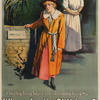8: Image, film advertisement, "Where Are My Children?," 1916.
In chapter 48 of Miriam Karpilove’s Diary of a Lonely Girl, the narrator and Rae discuss the film Where Are My Children? (Universal Films, 1916). This silent film directed by Philips Smalley and Lois Weber, based on the obscenity trial of Margaret Sanger, tells the story of an attorney who is prosecuting a doctor for illegal abortions when he learns that women he knows, including his own wife, have procured abortions from the doctor. At the start of the film a doctor makes a convincing case for legalizing contraception to prevent unwanted births in poor families, but as the film progresses it makes a case against wealthy women having abortions on a “whim.”
Suggested Activity: Ask your students to consider this poster. What does the advertisement reveal about the risqué content of the film—and what does it leave out? Ask your students if they experience Miriam Karpilove’s novel as similar to this poster in terms of its use of innuendo and euphemism. Your students may wish to compare this image to the cover of Miriam Karpilove’s Diary of a Lonely Girl (earlier in this resource kit) and discuss whether they represent women similarly, and, if so, why that might be. They may also discuss the apparent relationship between the nurse in the background of the image on the poster and the woman in the foreground. What do their expressions and body language suggest? How does the nurse seem to feel about the woman in the foreground? Ask students to consider whether this nurse seems in any way similar to the landladies in Karpilove’s novel.
Ask your students to consider why Karpilove would reference this film in her novel: Does it situate the novel more firmly in a certain time period and cultural setting? Does it communicate a context of debate about birth control that extends beyond the characters in the novel itself (and one that extends outside of Yiddish-speaking circles)? Karpilove’s narrator is against birth control as she is concerned that the possibility of pregnancy is one of the only ways women have power in a relationship, and she and Rae allude to this film as a way of expressing their anti-birth control leanings. Yet the film itself is told from a male perspective—a man who wants to know what happened to the children he was prevented from having due to birth control. Ask your students to consider: according to their reading of Karpilove’s text, to what extent does the possibility of getting pregnant actually give Karpilove’s narrator power? Ask your students if they think that introducing an allusion to this film strengthens Karpilove’s narrator’s case against birth control or undermines it.
Source: “Where Are My Children?” (1916), movie poster, Wikimedia Commons, https://commons.wikimedia.org/wiki/Category:Where_Are_My_Children%3F#/media/File:Where_are_my_children_poster.jpg.
Where_are_my_children_poster.jpg
 Download image (76.03 KB)
Download image (76.03 KB)

